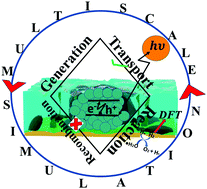Challenges of modeling nanostructured materials for photocatalytic water splitting
Abstract
Understanding the water splitting mechanism in photocatalysis is a rewarding goal as it will allow producing clean fuel for a sustainable life in the future. However, identifying the photocatalytic mechanisms by modeling photoactive nanoparticles requires sophisticated computational techniques based on multiscale modeling. In this review, we will survey the strengths and drawbacks of currently available theoretical methods at different length and accuracy scales. Understanding the surface-active site through Density Functional Theory (DFT) using new, more accurate exchange–correlation functionals plays a key role for surface engineering. Larger scale dynamics of the catalyst/electrolyte interface can be treated with Molecular Dynamics albeit there is a need for more generalizations of force fields. Monte Carlo and Continuum Modeling techniques are so far not the prominent path for modeling water splitting but interest is growing due to the lower computational cost and the feasibility to compare the modeling outcome directly to experimental data. The future challenges in modeling complex nano-photocatalysts involve combining different methods in a hierarchical way so that resources are spent wisely at each length scale, as well as accounting for excited states chemistry that is important for photocatalysis, a path that will bring devices closer to the theoretical limit of photocatalytic efficiency.



 Please wait while we load your content...
Please wait while we load your content...